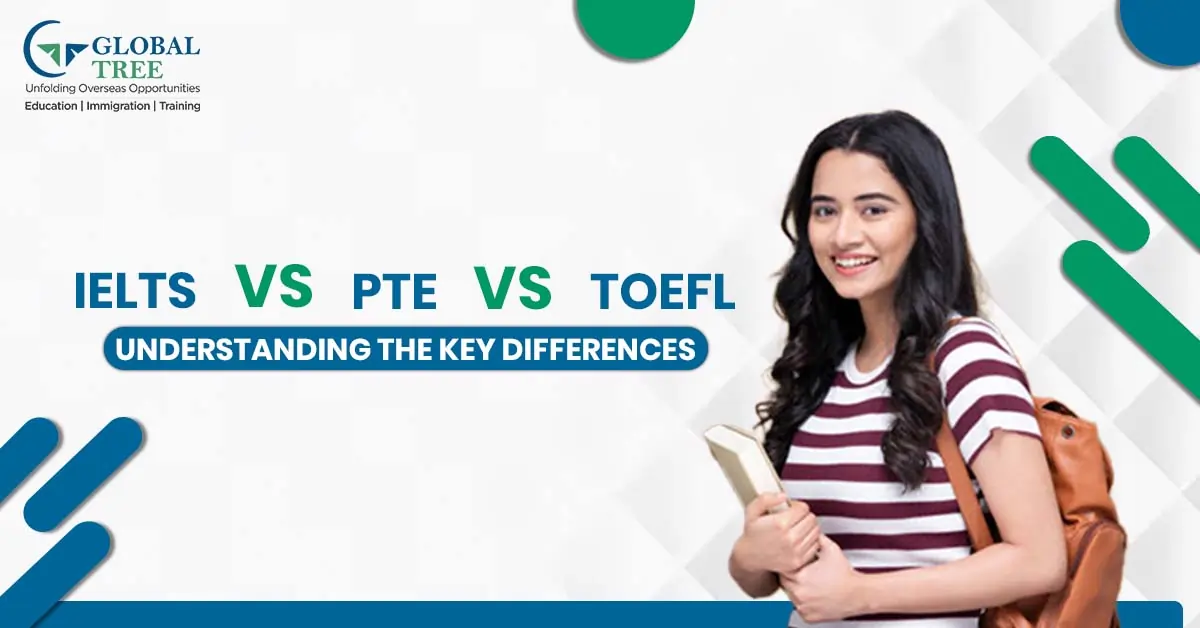IELTS Vs PTE Vs TOEFL: Understanding the Key Differences

Introduction
If you want a brighter future for yourself, studying in another country, working in an English-speaking country, or immigrating to a different country, you absolutely need to be fluent in the English language. The three standardised tests that are most frequently recognised for determining one's level of English proficiency are the Test of English as a Foreign Language (TOEFL), the International English Language Testing System (IELTS), and the Pearson Test of English (PTE).
In this comprehensive tutorial, we are going to go deep into the patterns, scoring mechanisms, and distinguishing characteristics of the IELTS, TOEFL, and PTE exams. We are going to go over the many parts of each examination, the distinctions that set them apart from one another, the benefits and drawbacks of each, and determine which one is likely to be perceived as being simpler by test takers. When you've finished reading this detailed guide, you'll have all the information you need to make an educated choice on which exam is the one that most closely matches your objectives.
IELTS vs. TOEFL vs. PTE
| NAME/SCOPE | IELTS | TOEFL | PTE |
|---|---|---|---|
|
Popular in |
UK, Europe, Australia |
USA, Canada, Europe |
Australia, USA, Canada |
|
Duration |
2hrs 45mins |
3hrs |
3hrs |
|
Total scores |
0-9 bands |
0-120 |
10-90 |
|
Fees* (approx) |
$215 |
$185 |
$183 |
Test Patterns
The structure of each test sets the foundation for how it assesses your English proficiency. Understanding these patterns is essential to prepare effectively.
IELTS Pattern:
IELTS offers two primary versions: Academic and General Training.
Academic IELTS: This version of IELTS is intended for individuals who want to pursue overseas education in English-speaking countries.
General Training IELTS: Designed for those who plan to migrate to English-speaking countries or seek employment.
The test consists of four main sections:
- Listening
- Reading
- Writing
- Speaking
The total duration of the IELTS test is approximately 2 hours and 45 minutes.
(Read More: IELTS and TOEFL: A Detail Comparison of the two exams)
TOEFL Pattern:
TOEFL is exclusively offered in an internet-based format (TOEFL iBT). It comprises four main sections:
- Reading
- Listening
- Speaking
- Writing
The TOEFL iBT test takes around 3 hours to complete.
PTE Pattern:
PTE is a computer-based test with three primary sections:
- Speaking & Writing
- Reading
- Listening
The total test duration for PTE is typically around 3 hours.
IELTS vs. TOEFL vs. PTE: Scoring Systems
Understanding the scoring systems of these tests is crucial because it determines how your language proficiency is evaluated.
IELTS Scoring System:
The International English Language Testing System (IELTS) uses a scoring system with a range from 0 to 9 that is referred to as "band scores." Listening, reading, writing, and speaking are all evaluated independently as separate components of the overall score. The overall IELTS score is calculated by averaging the points from each band.
TOEFL Scoring System:
Scores on the TOEFL iBT might range anywhere from 0 to 120. Reading, listening, speaking, and writing all receive a score out of a possible 30 points each. The sum of these four section scores constitutes your total score on the TOEFL.
PTE Scoring System:
The PTE employs a scoring scale that ranges from 10 to 90, with intervals of 10 points. There is no such thing as an overall score on the PTE, in contrast to the IELTS and TOEFL. Individual points are assigned to each of the three primary categories.
IELTS vs. TOEFL vs. PTE: A Closer Look at the Sections
Each test evaluates different aspects of English language proficiency through its sections. Let's dive deeper into the content and unique characteristics of these sections.
Reading Section:
IELTS Reading: Reading on the IELTS consists of excerpts from a variety of sources, including books, journals, periodicals, and newspapers. The range of topics is extremely broad and can include anything from science to the arts.
TOEFL Reading: Reading on the TOEFL focuses on academic literature and tests your ability to comprehend and evaluate different types of written material. Textbooks written for college-level students are often the source of passages.
PTE Reading: The reading portion of the PTE examines your comprehension skills using a combination of academic material and language that is used in everyday life. It consists of things like reordering paragraphs and quizzes with multiple-choice answers. Enrolling in PTE coaching will enhance your performance on the exam.
Listening Section:
IELTS Listening: This portion will test your ability to understand spoken English by exposing you to a wide range of regional and national accents, as well as several real-life scenarios. The listening resources are frequently based on actual conversations that have taken place.
TOEFL Listening: This section of the TOEFL tests your ability to listen to university-level lectures and classroom discussions. This section makes use of academic language, which is appropriate given that it is situated inside the realm of higher education.
PTE Listening: The listening portion of the PTE tests your ability to comprehend spoken language in a variety of natural settings and with a variety of accents. It also covers activities in which you are required to summarise verbal content.
Speaking Section:
IELTS Speaking: The speaking component of the IELTS test consists of a face-to-face interview with an examiner, which evaluates your ability to communicate and convey thoughts. A warm-up, a speaking assignment using cue cards, and a discussion are the three components that make up the overall format.
TOEFL Speaking: The speaking portion of the TOEFL requires test takers to reply to speaking prompts by speaking into a computer microphone. Some tasks are independent of one another, such as expressing opinions, as well as interconnected tasks, such as listening and speaking.
PTE Speaking: The speaking portion of the PTE requires the candidate to speak into a microphone and covers a wide variety of question types, such as reading aloud and summarising spoken text.
Writing Section:
IELTS Writing: The IELTS examination consists of two separate writing tasks: Task 1 (writing a report), and Task 2 (writing an essay). Participants in Task 2 are required to compose an essay in response to a question or statement presented to them.
TOEFL Writing: Writing on the TOEFL consists of both integrated and independent assignments, and its purpose is to measure a candidate's ability to build arguments that are logically consistent.
PTE Writing: The writing element of the PTE consists of three parts: answering questions based on hearing material, composing an essay, and summarising written text.
Major Differences between IELTS, TOEFL, and PTE
While the testing purposes are similar, there are significant distinctions between these exams that you should be aware of:
1. Test Availability and Centers:
IELTS and TOEFL: Test centers for the IELTS and TOEFL are widely available all around the world, making it reasonably simple to locate a center in which to take the examination.
PTE: Compared to other types of testing centers, PTE centers are not as widely available, which might make it challenging to schedule test dates, particularly in certain regions.
2. Test Format:
IELTS: The IELTS provides candidates in certain regions with the opportunity to take the exam either on paper or on a computer.
The Test of English as a Foreign Language (TOEFL) is delivered solely in an internet-based version (TOEFL iBT).
(Read More: What is the TOEFL test format and syllabus?)
The PTE is a test that is done on a computer and is well-known for its up-to-date testing format.
3. Retake Policy:
IELTS: You are allowed an infinite number of retakes on the IELTS. However, test-takers are only allowed to retake the exam a maximum of twice in twelve days due to this limitation.
PTE: The PTE test allows for an unlimited number of retakes, and there are no set time constraints; this provides the flexibility to retake the test whenever necessary.
The maximum number of times you are permitted to take the TOEFL in a given year is five, and the retake window for the exam is 12 days.
4. Result Reporting Time:
IELTS and TOEFL: The results of the IELTS and TOEFL are often reported later than those of other standardized tests, which may cause your application deadlines to be delayed.
PTE: The results of the PTE are sent quickly, often within five business days after the test has been taken. Those who are up against stringent application deadlines may find this to their benefit.
Pros & Cons of PTE Vs TOEFL Vs IELTS
IELTS, TOEFL, and PTE Each Have Their Benefits and Drawbacks
Having a thorough understanding of the benefits and drawbacks associated with each test can assist you in making an educated decision.
Advantages of IELTS:
IELTS Is Recognised Globally as the International English Language Testing System (IELTS) is accepted by universities, colleges, and immigration agencies in a variety of English-speaking nations, such as the United Kingdom, Australia, Canada, and New Zealand.
The IELTS provides candidates with a choice between two core modules—the Academic and General Training modules—which enables the exam to be utilized for a wide range of contexts.
Disadvantages of IELTS:
Evaluation of Speaking: The IELTS Speaking section is presented in the form of a face-to-face interview, which some candidates find to be an intimidating testing method.
IELTS test centers may be harder to reach than the TOEFL test centers in certain areas of the world due to IELTS' limited availability.
Advantages of TOEFL:
TOEFL is the favored Option for Many Universities in the U.S. Because the TOEFL is the favored option for many universities in the United States, it is an ideal alternative for students who wish to study in the United States.
Test Centres That Are Conveniently Located: TOEFL test centers are widely available, even in tiny locations, which ensures that the exam is easier to obtain.
Disadvantages of TOEFL:
Cost: The TOEFL can be rather expensive in comparison to other English proficiency tests, which may be a problem for some test-takers who are concerned about their ability to afford the exam.
Time Limits That Are Very Severe: Both the listening and speaking portions of the TOEFL have very severe time limits, which might make it difficult for some test takers to efficiently manage their time.
Advantages of PTE:
Quick Results: Compared to the other three tests, the PTE has one of the quickest turnaround times for reporting test scores, typically within five business days.
Test style: Some test takers feel more at ease and less intimidated by the completely computer-based style of the PTE, particularly in the Speaking component.
Disadvantages of PTE:
Limited Test Centres: Because there are fewer PTE centers than there used to be, it is more difficult to organize a test date in certain places. This makes it more likely that your study plans will be disrupted.
Although PTE is generally accepted, particularly by governments and universities, its recognition may not be as widespread as that of IELTS or TOEFL, particularly in some programs and institutions.
(Read More: What are the best ways to prepare for the PTE exam?)
IELTS vs. TOEFL vs. PTE: Which is Easier?
It is crucial to have an understanding that an individual's perception of the difficulty of an exam might vary substantially from person to person. Depending on where they stand in terms of their proficiency in various language skills, certain tasks may be more difficult for some people while others may find them simpler.
IELTS: Some people believe that the IELTS is simpler because the Speaking component is conducted in the manner of a face-to-face interview. This format can feel more like a normal conversation.
TOEFL: Others choose the TOEFL because of its standardized computer-based format, which removes any possible biases associated with human examiners. This makes the TOEFL a popular option.
PTE: Some test takers might find the PTE to be more straightforward because of its computer-based format and speedy score reporting, both of which can help minimize the anxiety that is associated with waiting for results.
FAQs:
Q. Which exam is recommended to take when applying for immigration?
A: Both the IELTS and the PTE are generally recognized for use in immigration contexts. PTE is also approved in several different immigration procedures, although IELTS is frequently favored in nations such as Canada and Australia.
Q. Is there a minimum or maximum age requirement to take these examinations?
A: There is no upper age limit for taking the IELTS, TOEFL, or PTE exams. Everyone of any age is welcome to take part in these examinations.
Q. May I transmit my standardized test results to more than one college or university?
A: Yes, you can choose more than one recipient for each of your results across all three assessments. This enables you to submit applications to several schools without the need to sit for separate test sessions at each university.
Q. Am I only allowed to take these tests a certain number of times before they become invalid?
A: For both the IELTS and the TOEFL, the number of times an exam can be retaken within a given time frame is capped. The IELTS exam can be retaken an unlimited number of times; however, candidates are only allowed to do so a maximum of twice within twelve days. There are a maximum of five opportunities to take the TOEFL exam within one year, and the waiting period between tries is 12 days. Seeking expert coaching on the TOEFL exam would enhance your preparation. In contrast, the PTE allows for an unlimited number of retakes and does not impose any set time constraints, providing the flexibility to retake the test whenever it is necessary to do so.
Q. Do I need to study for these exams, or am I able to take them without having done any prior preparation?
A: Although it is possible to take these tests without having prepared in advance, it is strongly encouraged that you spend some time doing so. Your chances of earning a higher score on a test that has a structure and requirements that are specific to that test are considerably improved if you prepare for that test. To improve your performance, you can improve your performance by accessing official preparation resources, taking practice examinations, and considering enrolling in preparation courses.






